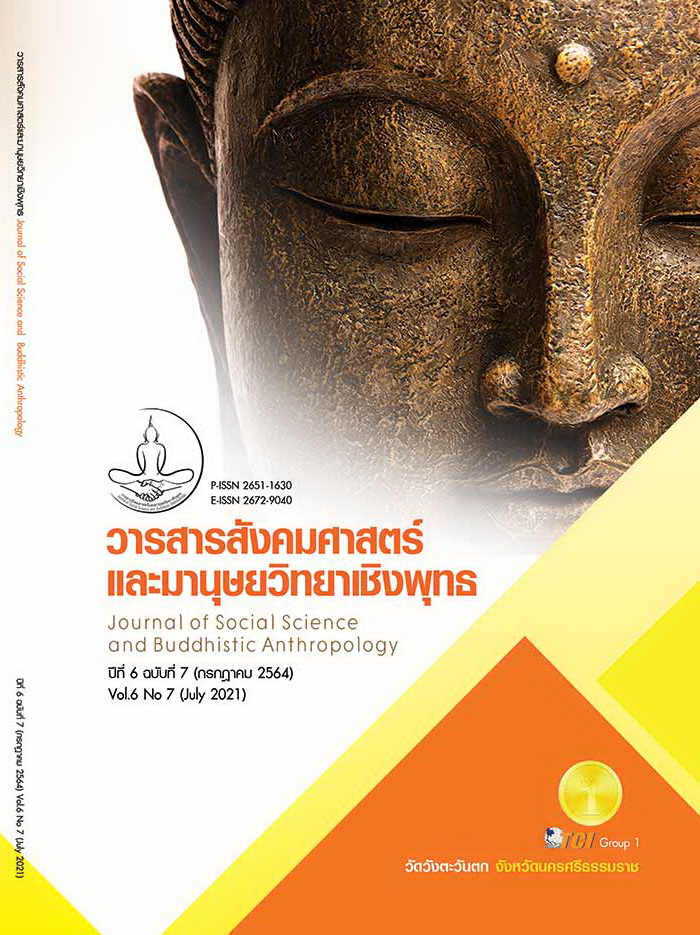THE DEVELOPMENT OF THE TRAINING CURRICULUM FOR ENHANCE ACTIVE LEARNING MANAGEMENT ABILITIES OF PRIMARY SCHOOL TEACHERS IN UBONRATCHATHANI PRIMARY EDUCATIONAL SERVICE AREA
Keywords:
The Training Curriculum, Active Learning Management Abilities, Primary School TeachersAbstract
The objectives of this research article were to 1) study active learning management abilities of primary school teachers 2) study problems and needs of the training curriculum to enhance active learning management abilities of primary school teachers 3) develop the training curriculum to enhance active learning management abilities of primary school teachers and 4) examine the effectiveness of the training curriculum to enhance active learning management abilities of primary school teachers. The research method including study problems and needs of the training curriculum, develop the training curriculum to enhance the active learning management abilities of primary school teachers, experiment, study the results of the training curriculum developed. The sample was 459 primary school teachers for fundamental information. There were 26 primary school teachers for the experiment by using a multi-stage random sampling technique. Data analyses were used mean, percentage, standard deviation, and t-test statistics with dependent and independent samples and content analysis. The findings of the research study were as follows: 1) active learning management abilities of primary school teachers were consists of 10 areas. 2) problem and needs of the training curriculum the overall is at the highest level, 3) the training curriculum has the following components were: 3.1) principle, 3.2) objectives, 3.3) structure 3.4) Contents, 3.5) training process 3.6) media and Learning resources, and 3.7) measurement and evaluation, 4) The active learning management abilities of the primary school teachers it was found that the experimental group had a higher score than the control group with statistical significance at the .01 level
References
ฆนัท ธาตุทอง. (2550). เทคนิคการพัฒนาหลักสูตรสถานศึกษา. (พิมพ์ครั้งที่ 3). นครปฐม: เพชรเกษมการพิมพ์.
ชัยวัฒน์ สุทธิรัตน์. (2556). การพัฒนาหลักสูตร ทฤษฎีสู่การปฏิบัติ. กรุงเทพมหานคร: วิพรินท์.
เชิดศักดิ์ ภักดีวิโรจน์. (2556). ผลการจัดการเรียนรู้เชิงรุก เรื่อง ทักษะและกระบวนการทางคณิตศาสตร์ที่มีต่อความสามารถในการแก้ปัญหาทางคณิตศาสตร์ การคิดอย่างมีวิจารณญาณ และความเชื่อมั่นในตนเองของนักเรียนชั้นมัธยมศึกษาปีที่ 3. ใน วิทยานิพนธ์การศึกษามหาบัณฑิต สาขาวิชาคณิตศาสตร์. มหาวิทยาลัยศรีนครินทรวิโรฒ.
ไชยยศ เรืองสุวรรณ. (2553). การออกแบบพัฒนาโปรแกรมบทเรียนและบทเรียนบนเว็บ. (พิมพ์ครั้งที่ 15). มหาสารคาม: มหาวิทยาลัยมหาสารคาม.
ฐีระ ประวาลพฤกษ์. (2538). การพัฒนาบุคคลและการฝึกอบรม. กรุงเทพมหานคร: หน่วยศึกษานิเทศก์ สำนักงานสภาสถาบันราชภัฏ.
ทิศนา แขมมณี. (2545). ศาสตร์การสอน. กรุงเทพมหานคร: สำนักพิมพ์แห่งจุฬาลงกรณ์มหาวิทยาลัย.
บุญชม ศรีสะอาด. (2554). การวิจัยเบื้องต้น. (พิมพ์ครั้งที่ 9). กรุงเทพมหานคร: บริษัท สุวีริยาสาส์นจำกัด.
ปฏิพงศ์ จงรู้ธรรม. (2558). การพัฒนาหลักสูตรฝึกอบรมเพื่อเสริมสร้างสมรรถนะด้านการจัดการเรียนการสอนของพนักงานมหาวิทยาลัยสายผู้สอน มหาวิทยาลัยเทคโนโลยีราชมงคลอีสาน. วารสารมนุษยศาสตร์และสังคมศาสตร์ (สทมส.), 22(2), 88-99.
ประสิทธิ์ ประมงอุดมรัตน์. (2553). การพัฒนาหลักสูตรฝึกอบรมครูด้วยวิธีผสมผสานในการจัดฝึกอบรมนักเรียนอาชีวศึกษา เพื่อเตรียมความพร้อมสำหรับการฝึกประสบการณ์วิชาชีพ. วารสารวิชาการครุศาสตร์อุตสาหกรรม พระจอมเกล้าพระนครเหนือ, 2(2), 41-50.
พิมพ์พันธ์ เดชะคุปต์ และพเยาว์ ยินดีสุข. (2559). สอนเด็กทำโครงงาน สอนอาจารย์ทำวิจัยปฏิบัติกการในชั้นเรียน (PBL - CAR). กรุงเทพมหานคร: โรงพิมพ์แห่งจุฬาลงกรณ์มหาวิทยาลัย.
เยาวเรศ ภักดีจิตร. (2557). Active Learning กับการเรียนรู้ในศตวรรษที่ 21. ใน เอกสารประกอบการเสวนาทางวิชาการวันส่งเสริมวิชาการสู่คุณภาพการเรียนการสอน 30 กรกฎาคม 2557 . มหาวิทยาลัยราชภัฏนครสวรรค์.
เรวณี ชัยเชาวรัตน์. (2558). การนำแนวคิดทีแพคไปใช้ในการเรียนการสอนเพื่อผู้เรียนในศตวรรษที่ 21. ครุสาร มหาวิทยาลัยราชภัฏนครราชสีมา, 6(1), 1-13.
วัชรี เกษพิชัยณรงค์ และคณะ. (2555). การเรียนเชิงรุกและเทคนิคการจัดการเรียนการสอนที่เน้นการเรียนเชิงรุก. กรุงเทพมหานคร: มหาวิทยาลัยกรุงเทพ.
วิจารณ์ พานิช. (2557). การเรียนรู้เกิดขึ้นอย่างไร. (พิมพ์ครั้งที่ 2). กรุงเทพมหานคร: มูลนิธิสยามกัมมาจล.
วิเชียร เกตุสิงห์. (2538). ค่าเฉลี่ยและการแปลความหมาย. ข่าวสารวิจัยทางการศึกษา, 18(3), 8-11.
ศักดา ไซกิจภิญโญ. (2548). สอนอน่างไรให้ Active Learning. นวัตกรรมการเรียนการสอน, 2(2), 12-15.
สมคิด บางโม. (2554). เทคนิคการฝึกอบรมและการประชุม. (พิมพ์ครั้งที่ 4). กรุงเทพมหานคร: วิทยพัฒน์.
สำนักงานเลขาธิการสภาการศึกษา. (2556). บทวิเคราะห์สถานภาพการพัฒนาครูทั้งระบบและข้อเสนอแนะ แนวทางการพัฒนาครูเพื่อคุณภาพผู้เรียน. (พิมพ์ครั้งที่ 2). กรุงเทพมหานคร: พริกหวานกราฟฟิค.
สำลี รักสุทธี. (2544). เทคนิควิธีการจัดการเรียนและเขียนแผนการสอน โดยยึดผู้เรียนเป็นสำคัญ. กรุงเทพมหานคร: พัฒนาศึกษา.
Beach, D. S. (1970). Personal: The management of people at work (2nd ed). New York: Macmillan.
Good, C. V. (1973). Dictionary of Education. New York: McGraw - Hill Book.
Parsloe, E. (1992). Coaching, mentoring and assessing: A practical guide to developing competence. London: Kogan Page.
Spark, D. & Loucks-Horsley, S. (1989). Five models of staff development for teachers. Journal of Staff Development, 10(4), 40-57.
Sutherland, T. E., & Bonwell, C. C. eds. (1996). Using Active Learning in College Classes: A Range of Options for Faculty. San Francisco: Jossey-Bass.








